 |
||
|
||
| ||
Part 3: Performance in games
TABLE OF CONTENTS
Test results: performance comparisonYou can look up the testbed configuration here We used the following test applications:
You can download test results in EXCEL format: RAR and ZIP
If you understand 3D graphics, you may draw your own conclusions from the diagrams below. If you are interested in our comments on test results, you may read them after each test. What concerns beginners and those who just started to look for a video card, we shall include some detailed explanations. Firstly, you should look through our reference materials on modern video cards and their GPUs. Note operating frequencies, support for modern technologies (shaders), as well as a pipeline architecture. You should understand that the 8800 family of accelerators abolished the notion of a pipeline. These cards have streaming processors, which process shader commands in a game. Texture units process pixels (applying textures, filtering) by themselves, that is the processes are fully divided. Data are written into a memory buffer, as always, only after texture operations. The old procedure was to take a triangle, calculate it with shader commands, apply texture(s), filter it, and send it along; this procedure is not used anymore. It's up to a driver and a thread processor to distribute tasks between stream processors. The same concerns texture units. The 8600 series is in a similar situation.
ATI RADEON X1300-1600-1800-1900 ReferenceNVIDIA GeForce 7300-7600-7800-7900-8800 ReferenceSecondly, if you have just faced the problem of choosing a video card and are at a loss, our 3D-Video section offers articles about 3D basics (you will still have to understand them - when you run a game and open its options, you'll see such notions as textures, lighting, etc) as well as reviews of new products. There are just two companies that manufacture graphics processors: ATI (it has been recently bought by AMD and now bears the same name - AMD) and NVIDIA. So most information is divided into these two sections. We also publish monthly 3Digests that sum up all comparisons of video cards for various price segments. Thirdly, we'll have a look at the tests. FarCry, Research (No HDR)
 Alas, the first test shows that even higher frequencies do not help the new product demonstrate its strong points. In fact only the X1650XT is outperformed. That's a mediocre achievement, considering prices of both cards.
FarCry, Research (HDR)
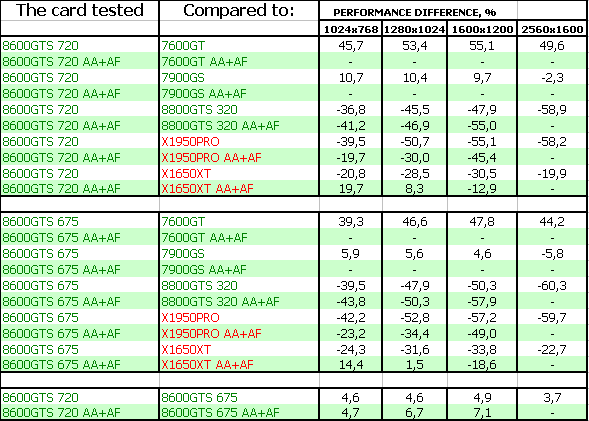 The situation has become worse in terms of competition with AMD/ATI. But the new product fares well against the 7xxx series (it even outperforms the 7900GS).
F.E.A.R.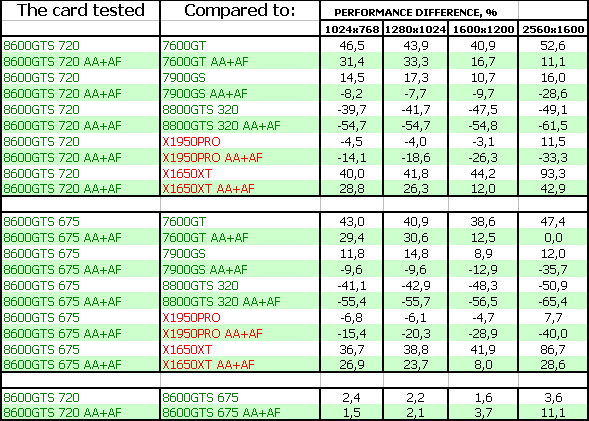 This game has much higher requirements to performance of a shader unit than the previous. So we see a different situation here: the 8600 GTS has outperformed the X1650 XT (which is cheaper, actually). It's faster than the 7900 GS without AA+AF (to say nothing of the 7600 GT). And it's outperformed by the 7900 with AA+AF (OK, it's the effect of the 256-bit memory bus; translated to a 128-bit bus in the 7900 GS, we get 2600 MHz instead of 2000 in the 8600). But the new product is defeated by its main competitor - X1950 PRO.
Splinter Cell Chaos Theory (No HDR)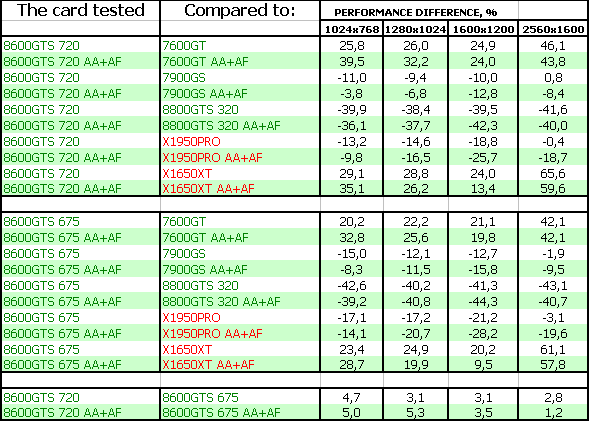 The situation with the 8600 GTS is far from cheerful, it outperforms only cheaper X1650 XT and 7600 GT cards.
Splinter Cell Chaos Theory (HDR) The same thing.
Call Of Juarez It's a similar situation. We can only note that the 7900 GS is outperformed here. Company Of Heroes And this is the most horrible sight... a defeat on all fronts. :(
Serious Sam II (No HDR)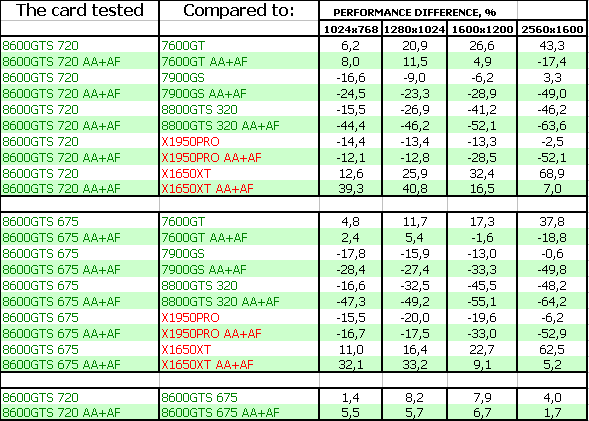 The new product outperforms only cheaper cards again. Its competitors from the same price segment are stronger.
Serious Sam II (HDR)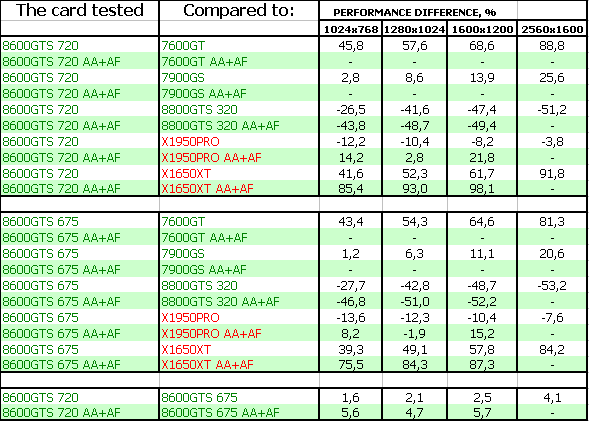 The same thing.
Prey
Strange as it may seem, even OpenGL does not change the situation.
3DMark05: MARKS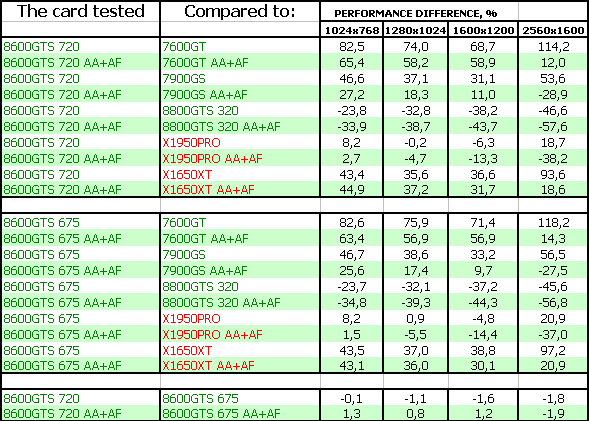
3DMark06: SHADER 2.0 MARKS

3DMark06: SHADER 3.0 MARKS

But purely synthetic shader tests show that the 8600 GTS is not that bad. But only in synthetic tests. Alas.
ConclusionsNVIDIA GeForce 8600 GTS (G84) 256MB PCI-E is generally stronger than the previous Mid-End GeForce 7600 GT in all tests. However, its price being $230-$250, this card looks worse not only than its AMD competitors, but also than the 7900 GS. The only ponderable advantage of the new product is its DX10 support. But we can neither test (there are no tests yet), nor compare anything here (similar products from AMD will appear only in May).
So we can highlight the following points:
We should also mention the new AA type - CSAA, which can replace MSAA.
Now what concerns drawbacks. First of all, it's a noisy cooler. We hope that future drivers will allow to control fan speed. The initial price of $230-$250 is too high. This price is evidently too high these days, as there is no need in DX10 support so far (there are no programs, and MS Vista drivers are still buggy), especially compared to GeForce 8800 GTS 320MB, which price will be initially higher by just $70-$80, but it's up to 50% faster in tests. The 8800 GTS 320MB will be an evidently better choice. But when the price drops to $170, the 8600 GTS will become very attractive. Another issue: games with frequencies. We don't know who invented this new game - to raise frequencies in press samples and offer them as regular cards (not overclocked). Perhaps they think that some reviewers may miss these frequencies, write about 675 MHz and publish higher results. But what about partners who announce their overclocked modifications? Just imagine: some company presents a video card operating at 700/2000 MHz and expects it to be faster than the model operating at 675/2000 MHz. But the tests were run on video cards actually operating at 725/2200 MHz instead of 675 MHz! So such a turbo card will demonstrate evidently worse results. In our opinion, the idea behind it is to trip NVIDIA partners in the first place. To say nothing of common users. Now what concerns the cards from MSI, ECS, Point Of View: they are all reference cards. That's obvious. There is no kick in them or their bundles. So just compare the prices and buy the cheapest card. We repeat once again: ALL THESE CARDS WILL GO FOR SALE AT 675/1450/2000 MHz! Not at 725/1450/2200 MHz like our samples. So, if the retail price does not exceed $200, the new product will be beyond competition. That's for sure... for now. Because a new series of Mid-End DX10 cards from AMD/ATI is expected in May. We'll draw final conclusion after the comparison with those products. That's why we are waiting for the response from AMD. One more article will be published about the 8600 series, which will be devoted to GeForce 8600GT, 8500GT and 8600GTS SLI. Watch our announcements!
And here is one more thing that will be repeated in each review. Having decided to choose a 3D accelerator on your own (a video card in your computer), you should understand that you change one of the key components of your system unit, which may require additional configuration for better performance or you may have to enable some functions to achieve higher quality. This is not an end product, it's just a component. So you should understand that you'll have to learn 3D graphics basics in order to get maximum performance from a new video card. And some graphics as well. If you don't want to deal with it, you shouldn't upgrade your computer on your own: you'd better buy ready PCs with preconfigured software (you'll also have technical support by your system integrator), or game boxes, where no configuration is required, everything necessary is already configured in a game. You can find more detailed comparisons of various video cards in our 3Digest.
ATI RADEON X1300-1600-1800-1900 ReferenceNVIDIA GeForce 7300-7600-7800-7900 Reference
We'd like to thank
MSI Russia and Alexander Nemoshkalov IT Labs and Natasha Lagunenko Point Of View for the provided video cards
Andrey Vorobiev (anvakams@ixbt.com)
May 29, 2007 Write a comment below. No registration needed!
|
Platform · Video · Multimedia · Mobile · Other || About us & Privacy policy · Twitter · Facebook Copyright © Byrds Research & Publishing, Ltd., 1997–2011. All rights reserved. |